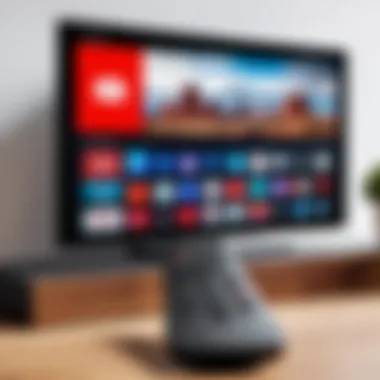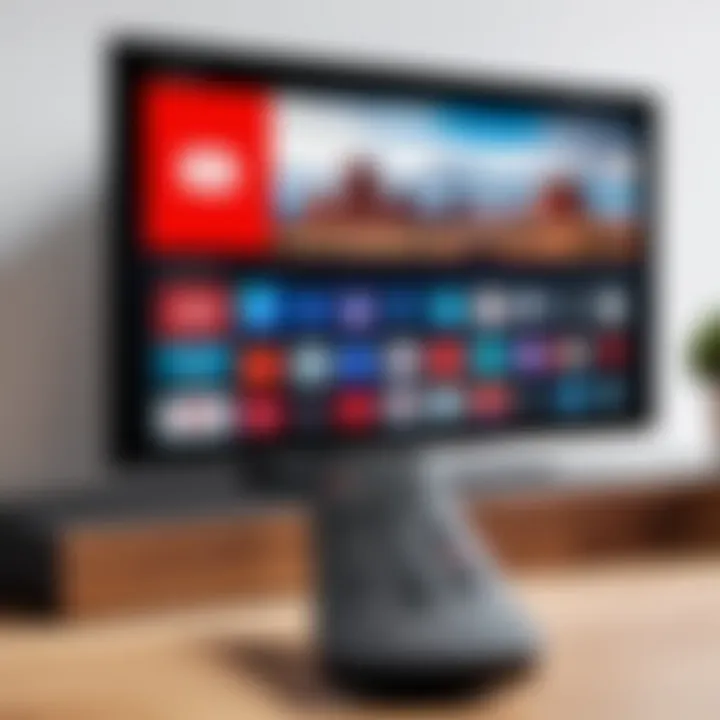Connecting YouTube to Your TV: A Comprehensive Guide


Intro
Connecting YouTube to a television may seem straightforward, yet there exist various methods to achieve optimal viewing experiences. With technology evolving rapidly, an understanding of the options available ensures users can fully enjoy their favorite YouTube content from the comfort of their living rooms. Whether you possess a smart TV with built-in capabilities or rely on external devices, this guide will provide clear instructions and insights.
Overview of the Technology
In this section, we discuss the technology behind connecting YouTube to your TV, emphasizing the various methods available.
Key specifications
To start, the integration of YouTube on TVs typically hinges on two primary factors: internet connectivity and the device's operating system. Most smart TVs come equipped with Wi-Fi capabilities, enabling seamless access to online platforms like YouTube. Alternatively, streaming devices such as Chromecast or Amazon Fire TV Stick depend on either HDMI ports or Wi-Fi for transmission.
Unique selling points
The biggest advantage of linking YouTube to a TV is the enhanced viewing experience. Not only does the larger screen provide a more immersive experience, but high-definition visuals and surround sound can significantly elevate enjoyment. For those inclined towards smart home integration, some technologies enable control through voice commands, adding convenience to the viewing experience.
"Connecting modern technology to traditional screens allows users to merge old with new, creating unique entertainment landscapes."
Design and Build Quality
Discussing design here illustrates how form factors can influence usability.
Material used
Smart TVs today often feature high-quality materials, including sleek plastic casings and tempered glass screens that enhance aesthetic appeal. Additionally, external devices are generally compact, utilizing robust materials that ensure durability while maintaining portability.
Ergonomics and usability
Usability is crucial. Most smart TVs possess user-friendly interfaces that simplify navigation. Buttons on remote controls, including dedicated YouTube shortcuts, improve accessibility. On the other hand, devices like Roku and Apple TV provide intuitive setups that allow even non-tech-savvy individuals to connect to YouTube with minimal effort.
Understanding the Basics of YouTube Streaming
YouTube has become a pivotal platform for video consumption globally. Understanding the basics of YouTube streaming sets the stage for more complex connections between your devices and the service. This section provides insights into what YouTube is and why streaming services, in general, have surged in popularity.
What is YouTube?
YouTube is a video-sharing platform where users can upload, view, and share videos. Launched in 2005, it has evolved into a significant repository for diverse content, ranging from educational videos to entertainment. Users are drawn to the vast array of material available, and it serves billions of views daily. The platform allows creators to reach audiences worldwide, enabling the democratization of content. Understanding its function is essential as it forms the basis of connecting to TVs and other devices.
The Rise of Streaming Services
The ascendancy of streaming services like YouTube reflects broader trends in media consumption. Traditional cable television has seen a decline as streaming offers more flexibility. Viewers can choose what to watch and when to watch it, often for a lower cost.
Several key factors contribute to the rise of streaming services:
- Accessibility: Users can access YouTube from various devices including smartphones, tablets, and TVs.
- Content Variety: The platform hosts content from amateur creators, experts in their fields, and established media organizations.
- Interactivity: Streaming services allow users to engage—through comments, likes, or shares—creating a more interactive experience than conventional television.
"The shift from traditional media to streaming is not just a trend; it reflects changing consumer preferences and technological advancements."
In summary, knowing the key aspects of YouTube and the impact of streaming services provides necessary context for discussing how to connect this platform to television. It also illustrates the importance of optimizing viewing experiences across various devices.
Types of TVs Compatible with YouTube
Understanding the types of TVs that can connect to YouTube is essential for users looking to utilize their television's capabilities fully. This section outlines the differences between Smart TVs and Non-Smart TVs, focusing on their compatibility with YouTube and the implications for the viewing experience. Knowing what type of TV you have can help in selecting the right method for accessing content on a larger screen, ensuring a satisfying integration of technology into your entertainment routine.
Smart TVs
Smart TVs have revolutionized how we consume media. These devices come with built-in apps, including YouTube, allowing seamless access with no additional hardware required. From brands like Samsung to LG, the interface is often user-friendly and intuitive. Users can navigate through YouTube content easily with their remotes.
Benefits of Smart TV integration include:
- Direct Access: You can open YouTube directly from the home screen.
- Multifunctionality: Smart TVs often support various apps aside from YouTube, enhancing their overall usability.
- Regular Updates: Most Smart TVs receive firmware updates, which can improve app performance and security.
However, not all Smart TVs are equal. Older models may not support the latest version of the YouTube app or other functionalities, so it is wise to check for firmware updates. You should also verify that the model supports streaming quality preferences that meet your needs, such as 1080p or 4K.


Non-Smart TVs and Compatibility Options
For Non-Smart TVs, there are still ways to enjoy YouTube content, but they require additional devices. Non-Smart TVs generally lack the capability to connect to the internet directly. Thus, users must find alternative methods to stream YouTube videos.
Options available for Non-Smart TVs include:
- Streaming Devices: Devices like Roku, Amazon Fire Stick, and Apple TV can be connected through HDMI ports, providing a user-friendly way to access YouTube.
- Casting Devices: Utilizing technologies such as Chromecast can turn a Non-Smart TV into a smart streaming machine by allowing video casting from mobile devices.
- Screen Mirroring: This allows users to mirror content playing on smartphones or tablets directly onto the TV. However, the experience may vary depending on the device's capabilities and the TV's specifications.
Connecting YouTube to Smart TVs
Connecting YouTube to smart TVs is essential for those who want to leverage the full potential of both their device and the streaming platform. Smart TVs come equipped with built-in internet connectivity and proprietary applications, making access to YouTube seamless and straightforward. This section aims to illustrate important aspects such as ease of use, convenience, and the potential for an enhanced viewing experience.
Using the Built-in YouTube App
Most smart TVs include the YouTube application pre-installed. Accessing the app usually involves navigating through the home screen or the app menu, depending on the specific model. Once you find the YouTube app, simply select it to launch.
When using the app, you can sign in to your YouTube account for personalized content such as subscriptions and playlists. This simple step enhances interaction by allowing you to save favorites. Furthermore, with the built-in app, you benefit from a user interface optimized for larger screens, ensuring that navigation is user-friendly.
Key Advantages of Using the Built-in YouTube App:
- Instant Access: Launch the app directly without needing extra devices.
- Optimized Experience: Designed specifically for larger displays, improving viewing and navigation.
- Improved Performance: Streamlining the experience by utilizing the TV’s dedicated resources.
Updating Your TV’s Firmware
Another critical aspect to ensure a smooth YouTube experience is keeping your smart TV's firmware updated. Firmware updates can often bring new features, improved compatibility, and fixes for any existing bugs which could hinder functionality. Regular updates help maintain performance and security while using the YouTube app.
To check for updates, go to your TV’s settings menu and look for an option related to software or firmware updates. Depending on the brand of your TV, the steps may vary slightly, but the core principle remains the same. A strong internet connection is necessary during this process to download and install any available updates.
Steps to Update YouTube on Your Smart TV:
- Go to Settings: Access the main menu.
- Select Support/Help: This may differ based on brand.
- Choose Software Update: Identify if updates are available.
- Install If Available: Follow on-screen instructions to update.
Keeping your firmware updated is a fundamental part of maintaining your smart TV and ensuring optimal performance with applications like YouTube. Regular updates increase stability and enhance your streaming experience.
Connecting YouTube to Non-Smart TVs
Connecting YouTube to non-smart TVs can seem challenging at first. However, it is an essential topic in today’s streaming era. Many users own older televisions that do not have built-in internet capabilities. Still, it is possible to enjoy YouTube videos through various methods. This section outlines viable solutions and considerations for selecting the right approach.
Using Streaming Devices
Streaming devices play a crucial role in bridging the gap between non-smart TVs and modern streaming services like YouTube. They act as intermediaries, receiving internet signals and converting them to formats compatible with standard TVs. Below, we discuss three popular streaming devices: Roku, Amazon Fire Stick, and Apple TV.
Roku
Roku is regarded for its user-friendly interface and simplicity. One of its standout characteristics is the variety of channels available, YouTube included. Roku devices come in different models, catering to diverse needs and budgets.
A unique feature of Roku is the ability to customize its homepage with preferred channels, including YouTube. This makes accessing content straightforward. Additionally, its search functionality allows users to find YouTube videos across different channels. However, Roku may require frequent software updates to maintain functionality, which could be a minor inconvenience for some users.
Amazon Fire Stick
The Amazon Fire Stick is another viable option for accessing YouTube on non-smart TVs. Its key characteristic is the integration with the Amazon ecosystem, offering seamless connectivity to other Amazon services. This can enhance the overall experience for users already invested in Amazon products.
A unique feature of the Fire Stick is its Alexa voice control capabilities, allowing users to navigate YouTube hands-free. This is a significant convenience. However, some may find the Fire Stick's interface less intuitive compared to Roku. It may also include advertisements for other Amazon products, which might be distracting for some users.
Apple TV
Apple TV is often celebrated for its aesthetic and build quality. One important aspect is its strong integration with other Apple services. Users with iPhones or iPads may find Apple TV to be a harmonious addition to their existing setup.
A unique feature of Apple TV is AirPlay, which allows for easy streaming from Apple devices directly to the TV. This makes it ideal for users who prefer content on their mobile devices but want to view it on a larger screen. However, the cost of Apple TV tends to be higher than other streaming devices, which could be a disadvantage for budget-conscious consumers.
Screen Mirroring from Mobile Devices
Screen mirroring provides another method to connect YouTube to non-smart TVs. This technique utilizes mobile devices to display content on the TV screen. Most smartphones and tablets now support screen mirroring features. It allows users to share videos directly from their devices to the TV, enhancing accessibility without additional hardware. The process may vary slightly depending on the device, but it typically involves selecting the TV from a list of available devices in the screen mirroring settings.


Using screen mirroring is beneficial, but there are some considerations. For instance, both devices need to be connected to the same Wi-Fi network. Furthermore, the performance may depend on the strength of that connection. Lack of a stable connection during important viewing moments could lead to frustration.
Alternative Connection Methods
When connecting YouTube to your TV, various methods can be utilized. While smart TVs and streaming devices often take the limelight, alternative connection methods also play a critical role. This section delves into the significance of using options like HDMI cables and Chromecast, as they cater to different user preferences and situations.
One of the primary benefits of alternative connection methods is their versatility. They can often accommodate older TV models or setups that may not support built-in apps. Additionally, these options can enhance the viewing experience by providing more reliable connections or bypassing limitations that some smart TVs might have.
Using HDMI Cables
HDMI cables are a fundamental component when it comes to connecting devices. They facilitate high-quality video and audio transmission from one device to another.
To use HDMI for connecting YouTube, simply follow these steps:
- Connect one end of the HDMI cable into your laptop or mobile device.
- Plug the other end into an available HDMI port on your TV.
- Switch your TV’s source to the corresponding HDMI input.
- Open YouTube on your device and enjoy.
This method allows for a seamless experience without the need for additional apps. Furthermore, HDMI cables support resolutions up to 4K, delivering crisp visuals and sound quality for a rich viewing experience.
Do remember maintaining your HDMI cables. Sometimes frayed or old cables can lead to signal issues. Investing in a good quality cable is advisable for consistent performance.
Utilizing Chromecast
Chromecast presents a more wireless solution for connecting YouTube to your TV. It allows you to cast content directly from your mobile device or computer to the television without the need for physical cables.
To utilize Chromecast, you need:
- A Chromecast device connected to your TV’s HDMI port.
- A Wi-Fi network shared between your Chromecast and mobile device/computer.
Follow these straightforward steps:
- Install the Google Home app on your mobile device.
- Set up your Chromecast using the app, ensuring it’s connected to the same Wi-Fi network.
- Open the YouTube app on your mobile device.
- Tap on the cast icon from the YouTube app and select your Chromecast device.
- Choose the video you wish to play.
This method offers the advantage of controlling your viewing from your mobile device while freeing you from the limitations of screensize. Chromecast enhances the user experience, allowing for easy switching between devices. Also, it's convenient when sharing content with friends or family.
Using these alternative connection methods not only broadens the scope of accessibility but also optimizes the content viewing experience based on individual needs.
Troubleshooting Common Issues
When it comes to connecting YouTube to your television, encountering problems is not uncommon. This section addresses the troubleshooting of common issues that might arise. Recognizing and resolving these situations can significantly enhance your viewing experience, making it smoother and more enjoyable. This area of the guide is crucial because it empowers the user to independently address challenges rather than relying on external support. Understanding the tactics for solving problems can save you time and frustration.
Connection Problems
Connection issues can manifest in various ways when attempting to stream YouTube on your TV. These range from the inability to connect to network, to buffering issues that interrupt viewing. Here are some common problems and their potential solutions:
- Wi-Fi Connectivity: Ensure your TV is connected to the same Wi-Fi network as your streaming device or smartphone. Sometimes, simply reconnecting to the network resolves the issue.
- Network Speed: Slow internet can cause buffering. Testing your internet speed can help determine if that’s the root cause. Services like Speedtest can be used to check the speed.
- Device Restart: Often overlooked, restarting your television or streaming device can solve unexpected glitches or connection problems.
- App Updates: Ensure that the YouTube app on your TV is updated. Updates often include bug fixes that can resolve streaming issues.
In some cases, re-installing the YouTube app can clear persistent problems. Always check for updates on your television’s firmware as well. Keeping software current is essential for optimal performance.
Compatibility Issues
Compatibility is another critical aspect to consider when connecting YouTube to your TV. Ensuring that devices are properly compatible can save users from significant frustrations. Here are some points to note:
- Device Compatibility: Not all smart TVs support the YouTube app. If you have an older model, check its specifications to confirm. The lack of app availability can lead to confusion.
- HDCP Compliance: If you experience a black screen while streaming, it could be due to HDCP (High-Bandwidth Digital Content Protection) compliance. Verify that both your TV and streaming device support this feature.
- Format Issues: Ensure that the input format is compatible. If your TV supports 4K and your device outputs in 1080p, there shouldn’t be a problem, but ensure that all settings are correct.
In case of ongoing compatibility concerns, referring to the user manuals of both the TV and the streaming device might shed light on the issue. If a specific device fails to connect or display correctly, it might be beneficial to experiment with alternative devices. By understanding and addressing these compatibility aspects, you can significantly improve your streaming experience.
"Remember, sometimes the simplest solutions are the hardest to identify, so take a moment to consider the basics before troubleshooting further."
Resolving these common connection and compatibility issues plays a vital role in optimizing your YouTube viewing experience on TV. Being equipped with the right knowledge allows for a more seamless transition into the world of streaming.
Enhancing Your YouTube Experience
Enhancing your YouTube experience is critical for maximizing the potential of your viewing habits. With the broad range of content available on YouTube, it is essential to take advantage of features that streamline your navigation and personal enjoyment. Focusing on premium services and playlists can significantly improve how you consume videos. This section will detail the benefits of these features and how they integrate into your overall YouTube usage.


Setting Up YouTube Premium
YouTube Premium offers a distinct advantage for users seeking an uninterrupted viewing experience. By subscribing, users can enjoy ad-free content, which allows for seamless transitions between videos. This can be particularly beneficial during binge-watching sessions, as fewer disruptions lead to a better flow and immersion in the desired content. Additionally, YouTube Premium grants access to exclusive features such as background play, which lets you listen to audio from videos while using other apps or when the screen is off. This flexibility enhances the overall usability of the platform.
Setting up YouTube Premium is straightforward. Users can navigate to the YouTube app and find the subscription option in the settings menu. Here are the basic steps:
- Open the YouTube app or website
- Sign in to your Google account
- Click on the profile icon and select "Get YouTube Premium"
- Follow the instructions to complete the payment process
Once activated, you can start enjoying the features immediately with no additional setup needed. Users are also encouraged to explore family plans that allow sharing access among multiple accounts, providing a more economical solution for households with diverse viewing preferences.
Using YouTube Playlists
Playlists serve as an excellent organizational tool for managing and enjoying content on YouTube. By creating personalized playlists, users can group videos based on themes, genres, or personal interests, facilitating easier access to preferred content. This function is especially useful for long-term users who may follow numerous channels or wish to navigate vast video libraries without becoming overwhelmed.
To create a playlist, simply follow these steps:
- Sign in to your account on the YouTube app or website.
- Find a video you want to add to a new or existing playlist.
- Click the "Save" button underneath the video.
- Choose "Create new playlist" or select an existing one.
- Name your playlist and set its privacy settings.
Once established, playlists can be edited at any time. This adaptability allows users to keep their collections fresh by adding or removing videos. Curating playlists also enhances collaborative opportunities, as users can share their collections with friends and family, facilitating joint viewing experiences.
Safety and Security Considerations
In the age of digital content consumption, the importance of safety and security cannot be overstated. As individuals connect YouTube to their TVs, they expose themselves to potential risks. Understanding these risks and the measures to mitigate them should be a core aspect of any viewing experience. This section addresses crucial elements and offers insights into keeping your accounts and content safe.
Account Security
One of the most pressing concerns regarding YouTube on smart TVs is account security. Users typically log into their Google account to access YouTube features such as subscriptions, playlists, and viewing history. If your account is compromised, it could lead to unauthorized access, potentially altering your settings or subscriptions.
To safeguard your account, consider the following practices:
- Enable Two-Factor Authentication: This adds an extra layer of security. Even if a hacker gains access to your password, they will need a second form of verification.
- Regularly Update Passwords: Use complex passwords that combine letters, numbers, and symbols. Change them periodically, especially if you suspect any unusual activity.
- Monitor Account Activity: Regularly check your account for any unfamiliar activity. Google provides tools for reviewing recent login attempts.
Taking these precautions can help protect your YouTube account from being compromised, ensuring a secure viewing experience.
Content Safety
While enjoying YouTube content, users must also consider the safety of the material they are viewing. YouTube hosts a vast array of videos, but not all content is suitable for all audiences. Some may contain misinformation, explicit content, or harmful challenges.
To enhance content safety, users should:
- Utilize Restricted Mode: This feature limits the visibility of inappropriate content. Activating it can prevent younger viewers from accessing unsuitable videos.
- Report Inappropriate Content: If you encounter videos that promote harm or violate YouTube’s guidelines, report them. This helps maintain the community standards.
- Educate Yourself About Sources: Not all content is factual. Always cross-reference information, especially on sensitive topics.
By following these practices, you can create a safer YouTube viewing environment, making sure that the content consumed aligns with personal and familial values.
"When using streaming platforms, it is imperative to prioritize safety and security to ensure a positive experience."
In summary, managing safety and security considerations encompasses account protection and ensuring the integrity of the content accessed. By implementing these strategies, users can enhance their overall experience while mitigating potential risks.
Future Trends in Streaming Technologies
The shift in how we consume media has become markedly evident with the evolution of streaming technologies. As we look to the future, it is crucial to understand how these trends will impact the way we access and enjoy platforms like YouTube on our televisions. Such understanding not only enhances the viewing experience but also equips users with knowledge to make informed decisions about their technology purchases.
Advances in TV Technology
Advancements in television technology are swiftly transforming the landscape of home entertainment. Several developments are particularly noteworthy:
- 4K and 8K Resolution Televisions: These high-resolution displays offer exceptional picture quality and clarity. As streaming services like YouTube increasingly support higher resolution content, having a compatible TV allows viewers to fully appreciate the enhanced detail and color accuracy.
- OLED and QLED Panels: Technologies such as OLED (Organic Light Emitting Diode) and QLED (Quantum Dot LED) are redefining display capabilities. These technologies provide richer colors, deeper blacks, and faster response times. Their popularity indicates a trend where viewers prioritize immersive visual experiences.
- Integrated Smart Features: Modern TVs now come with built-in apps and voice control features, eliminating the need for additional devices. Compatibility with platforms like YouTube is essential for seamless access to content. This trend is likely to continue as manufacturers focus on enhancing user convenience and connectivity.
Overall, these technological advancements play a vital role in shaping the future of streaming. Consumers will benefit from more options and better quality, ensuring that watching YouTube on TV remains a premium experience.
Evolution of Streaming Services
The landscape of streaming services is constantly evolving, driven by user demand and technological advancements. A few notable considerations include:
- Subscription Models: The growth of subscription-based services has redefined content access. Platforms like YouTube have adapted by offering premium subscriptions that provide ad-free experiences and exclusive content. Understanding this shift can help users choose services that fit their needs.
- Content Diversification: As competition in the streaming market intensifies, platforms are increasingly investing in original content. YouTube is expanding its library with unique programming, aiming to attract a wider audience. This diversification highlights the necessity for viewers to stay informed about the latest offerings.
- Adaptive Streaming Technologies: Services like YouTube are implementing adaptive streaming, which adjusts video quality in real time based on available bandwidth. This technology ensures smooth viewing even in fluctuating network conditions, making it essential for users in varying regions.
The evolution of streaming services reflects a deep understanding of user preferences and a commitment to enhancing entertainment access. Keeping abreast of these changes is essential for anyone who wants to optimize their YouTube viewing experience on television.
"As technology advances, the way we interact with content evolves, prompting both excitement and some critical considerations regarding accessibility and quality."
The trends discussed offer valuable insight into the future of connecting YouTube to televisions. By being aware of these developments, viewers can maximize their enjoyment and remain aligned with the latest innovations in streaming technology.







